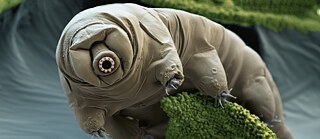Metabolic Stasis
Indestructible — The Astonishing Tardigrade
When the German zoologist Ephraim Goeze first recognized, described, and named the kleiner Wasserbär (“Little Waterbear”) in 1773, he could not yet have guessed that he had found the Chuck Norris of the animal kingdom: the Tardigrade — a creature so resilient and hardy that it can survive extreme temperatures, pressure, radiation, and even the vacuum of space by putting its metabolism on standby.
“What is the most boring pet you can think of? I’ll start: a tardigrade in its tun state.” If you got that joke, you already know what the tardigrade can do and how it does it. And chances are, you are also a fan of this tiny superhero that looks like a weirdo couch cushion with feet or a long-lost Pokémon drawn into existence by Susi Bumms.
Despite being an average of just a millimeter or less in size, tardigrades are badass tough and their amazing biology allows them to survive conditions that would doom most other cellular organisms. If the environmental conditions around tardigrades become unfavorable, they shut down their bodies through cryptobiosis, a process that puts tardigrades into a “tun state,” slowing their metabolism practically to a complete standstill, reducing their need for oxygen, and replacing the water in their cells with tardigrade-specific, glass-like proteins, preventing cellular damage that would otherwise occur. In this “freeze-dried,” dormant state, the tardigrades retract their heads and eight claw-fitted legs to resemble a microscopic peppercorn. They can survive like this for decades and only reanimate when living conditions are suitable again.
Phylum Tardigrada consists of over 1,000 species placed into three classes: Heterotardigrada, Eutardigrada, and Mesotardigrada — corresponding to roughly the marine, the terrestrial, and the freshwater varieties. Their phylum is notably entirely their own, without any relatives on their branch. Tardigrades grow through a series of molts, have a digestive tract, and feed on bacteria, plants, nematodes, and other microorganisms. They mate, lay eggs, mature, and while they are crappy parents, they are also quiet neighbors who present no harm or bother to humans.
Humans have every reason to be a little jealous of the charismatic bundles of wonder. Suppose we could mimic the tardigrade organism, bring our metabolism to a standstill, shelter, and hibernate in our indestructible bodies to endure extreme temperature, pressure, or radiation. In that case, we could easily sit out famines, climate catastrophes, and deadly radiation levels. And we would seriously go places — volcanos, the Mariana Trench, or interstellar travel... none of those superhero fantasies would be off-limits.
The tardigrade species does have an evolutionary leg up though; it’s been around for more than 500 million years, and given its superpowers, chances are it’ll stick around for a few more. Should, however, anything cataclysmic ever come our way and do our dear Mother Earth in, if given just enough time to morph into tun mode, the humble tardigrades are probably our best bet for maintaining life on earth... and perhaps even exporting it to other planets. And since Southpark Season 21, Episode 8 is obviously a documentary, we know that the kooky water bears dance to Taylor Swift’s music, so things are going quite swimmingly for life in the universe, no?
Hold Me Closer, Tiny Dancer
Tardigrades are ubiquitous on earth, living in practically every ecosystem our planet has to offer. They are found in terrestrial and aquatic environments, from the Arctic to the Antarctic, from the highest mountains to the greatest depths of the oceans... to your backyard. The little water dwellers just need a thin film of water to live in, which explains why they’re so comfortable living in the mossy patches of your garden and also how they earned the nickname “moss piglets.” (Convince yourself: A good microscope and a fresh patch of moss or lichens and a little care would allow you to observe the moss piglets doing their clumsy dances. Yes, they are THAT common.)Despite being an average of just a millimeter or less in size, tardigrades are badass tough and their amazing biology allows them to survive conditions that would doom most other cellular organisms. If the environmental conditions around tardigrades become unfavorable, they shut down their bodies through cryptobiosis, a process that puts tardigrades into a “tun state,” slowing their metabolism practically to a complete standstill, reducing their need for oxygen, and replacing the water in their cells with tardigrade-specific, glass-like proteins, preventing cellular damage that would otherwise occur. In this “freeze-dried,” dormant state, the tardigrades retract their heads and eight claw-fitted legs to resemble a microscopic peppercorn. They can survive like this for decades and only reanimate when living conditions are suitable again.
Phylum Tardigrada consists of over 1,000 species placed into three classes: Heterotardigrada, Eutardigrada, and Mesotardigrada — corresponding to roughly the marine, the terrestrial, and the freshwater varieties. Their phylum is notably entirely their own, without any relatives on their branch. Tardigrades grow through a series of molts, have a digestive tract, and feed on bacteria, plants, nematodes, and other microorganisms. They mate, lay eggs, mature, and while they are crappy parents, they are also quiet neighbors who present no harm or bother to humans.
Live on Mars
Their implausible resilience has often challenged scientists to see how far they can push the tardigrades — the tiny buggers have been boiled, frozen, and put under pressure equal to six times what you would experience at the bottom of the ocean (and easily double the pressure that would kill most other living things). In their tun state, their cellular stasis enabled them to survive at temperatures as low as -328 degrees Fahrenheit (-200 degrees Celsius) and as high as 304 degrees Fahrenheit (151 degrees Celsius) — try that in your sweater. Recent headlines include the successful revival of a group of tardigrades that had been frozen 30 years ago, while, anecdotally, there have been resurrections of even older tuns. Tardigrades are also seasoned astronauts: the European Space Agency (ESA) sent a batch of tardigrades on a space trip aboard an unmanned spacecraft in 2007, most of the colony survived the exposure to vacuum and cosmic rays, and some even managed to overcome solar UV radiation 1,000 times higher than on the surface of Earth. They traveled on Space X supply missions to the ISS, where they are regular subjects in the laboratories, and when the Israeli spacecraft Beresheet crashed into the moon during a failed landing attempt in 2019, it may have pollinated the lunar desert with thousands of dehydrated tardigrades.Improvise, Adapt, Overcome!
Their uncanny survival skills are matched only by their endearing odd looks, which secured them a place next to the axolotl and blobfish in the pantheon of unreasonably goofy-looking animals. You won’t have to look hard to find water bear fan forums, plush toys, or t-shirts to profess your admiration for this little ghostbuster end boss.Humans have every reason to be a little jealous of the charismatic bundles of wonder. Suppose we could mimic the tardigrade organism, bring our metabolism to a standstill, shelter, and hibernate in our indestructible bodies to endure extreme temperature, pressure, or radiation. In that case, we could easily sit out famines, climate catastrophes, and deadly radiation levels. And we would seriously go places — volcanos, the Mariana Trench, or interstellar travel... none of those superhero fantasies would be off-limits.
The tardigrade species does have an evolutionary leg up though; it’s been around for more than 500 million years, and given its superpowers, chances are it’ll stick around for a few more. Should, however, anything cataclysmic ever come our way and do our dear Mother Earth in, if given just enough time to morph into tun mode, the humble tardigrades are probably our best bet for maintaining life on earth... and perhaps even exporting it to other planets. And since Southpark Season 21, Episode 8 is obviously a documentary, we know that the kooky water bears dance to Taylor Swift’s music, so things are going quite swimmingly for life in the universe, no?






